7 June, 2000
Up from the Deep
June 7, 2000
Wait a minute! What’s Captain Garrett doing in the science lab drawing on
cups?
Captain Garrett is responsible for many of the operations on the Healy. He
is also keenly interested in what the scientists are learning through their
experiments. Today he’s joining us to have a little bit of scientific fun.
As you know, scientists are naturally curious people. They are always
asking, "I wonder what would happen if…?" Then they dream up experiments to
test their ideas.
No one knows who was the first person to wonder what would happen to a
styrofoam cup if it were lowered down to the bottom of the ocean. But the
famous experiment has become a tradition on oceanographic research cruises.
Janice and I had heard about this experiment before coming aboard the Healy.
We brought along styrofoam cups decorated by our students before we left.
These cups would be making the long journey to the bottom of the sea.
After Captain Garrett and the rest of the crew finished decorating their
cups, we placed them in a yellow net bag and attached them to the bottom of
the frame of the rosette sampling system. The rosette would carry several
different scientific instruments more than a mile down to the ocean floor.
Our styrofoam cups were along for the ride.
So what do YOU think happened to the cups? Here's a hint:
Have you ever dived to the bottom of a deep swimming pool? If so, you
probably have felt the pressure of the water on your ears as you got deeper
and deeper. This is called water pressure.
Every day we have air pressing on us from all directions. We don't really
notice it. When the water in the swimming pool presses down on us, though,
we can feel it. That's because water is so much heavier than air.
Now imagine diving more than a mile below the surface. If you look up, you
wouldn't even be able to see the sky - it would be too far away. Now think
of all that water pressing down on you. That's a lot of pressure!
That's just what was happening to our cups at the bottom of the ocean!
After an hour, the rosette was brought back up to the surface. We ran to
untie the net bags and take a look at our cups. Yikes! The cups had
shrunken! They were now miniature versions of the ones we had placed in the
bags!
Why did this happen? Think about how light styrofoam cups are. That's
because the styrofoam has lots of holes in it. Those holes are filled with
air. When the cups were under water, the pressure of the water squeezed all
of the air out of the styrofoam. The styrofoam material was compressed so
much that the cups shrunk to a fifth their normal size.
We’ll bring our cups back to school and share them with all of the students.
You don't have to wait until then to see them, though. Look below at the
pictures to see how they turned out.
Are scientists out here in the Arctic just to shrink styrofoam cups? Of
course, not! To find out about the rosette and what it does, click on
Janice’s page.
Janice's Entry
Today.
DAILY DATA LOG (6/07/00)
Air Temperature: 0 degrees C / 31 degrees F
SNOWING!!!
Latitude 60N
Longitude 56W
Sunrise 4:44 a.m.
Sunset 11:06 p.m.
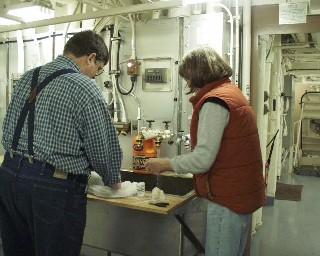
Mark Tilyou and Susan wash out the cups.
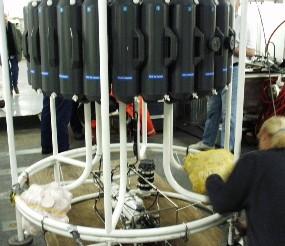
Andy Rowe attaches the bags filled with our styrofoam cups to the rosette frame.
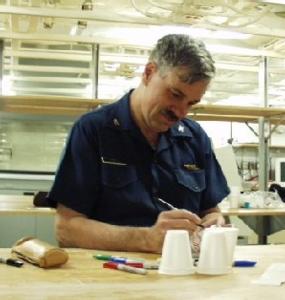
Captain Garrett takes time out of his busy schedule to decorate a cup.
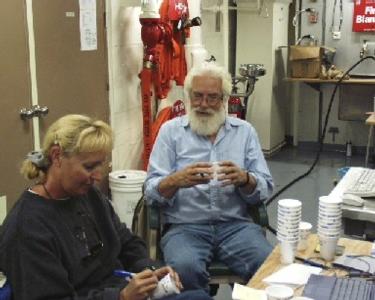
Andy Rowe (l) and Tony Amos (r) are preparing some cups for shrinking. Tony has been shrinking styrofoam cups since the early 70's. He offered us good advice on successful techniques.
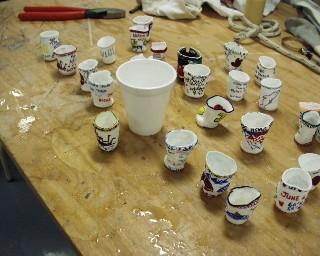
How did this happen?
Contact the TEA in the field at
.
If you cannot connect through your browser, copy the
TEA's e-mail address in the "To:" line of
your favorite e-mail package.
|
